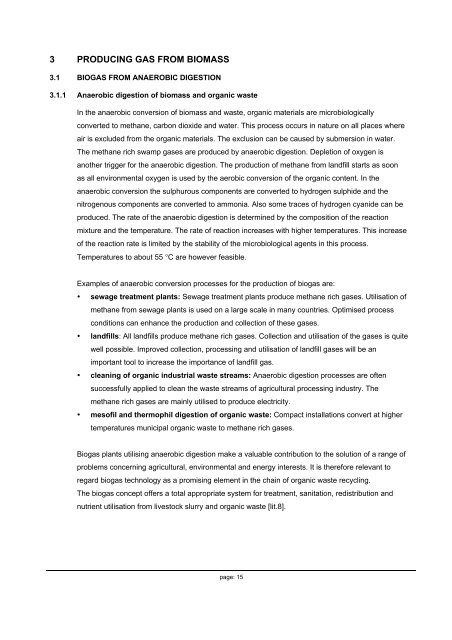Adding gas from biomass to the gas grid - SGC
Adding gas from biomass to the gas grid - SGC
Adding gas from biomass to the gas grid - SGC
- No tags were found...
You also want an ePaper? Increase the reach of your titles
YUMPU automatically turns print PDFs into web optimized ePapers that Google loves.
3 PRODUCING GAS FROM BIOMASS3.1 BIOGAS FROM ANAEROBIC DIGESTION3.1.1 Anaerobic digestion of <strong>biomass</strong> and organic wasteIn <strong>the</strong> anaerobic conversion of <strong>biomass</strong> and waste, organic materials are microbiologicallyconverted <strong>to</strong> methane, carbon dioxide and water. This process occurs in nature on all places whereair is excluded <strong>from</strong> <strong>the</strong> organic materials. The exclusion can be caused by submersion in water.The methane rich swamp <strong>gas</strong>es are produced by anaerobic digestion. Depletion of oxygen isano<strong>the</strong>r trigger for <strong>the</strong> anaerobic digestion. The production of methane <strong>from</strong> landfill starts as soonas all environmental oxygen is used by <strong>the</strong> aerobic conversion of <strong>the</strong> organic content. In <strong>the</strong>anaerobic conversion <strong>the</strong> sulphurous components are converted <strong>to</strong> hydrogen sulphide and <strong>the</strong>nitrogenous components are converted <strong>to</strong> ammonia. Also some traces of hydrogen cyanide can beproduced. The rate of <strong>the</strong> anaerobic digestion is determined by <strong>the</strong> composition of <strong>the</strong> reactionmixture and <strong>the</strong> temperature. The rate of reaction increases with higher temperatures. This increaseof <strong>the</strong> reaction rate is limited by <strong>the</strong> stability of <strong>the</strong> microbiological agents in this process.Temperatures <strong>to</strong> about 55 °C are however feasible.Examples of anaerobic conversion processes for <strong>the</strong> production of bio<strong>gas</strong> are:• sewage treatment plants: Sewage treatment plants produce methane rich <strong>gas</strong>es. Utilisation ofmethane <strong>from</strong> sewage plants is used on a large scale in many countries. Optimised processconditions can enhance <strong>the</strong> production and collection of <strong>the</strong>se <strong>gas</strong>es.• landfills: All landfills produce methane rich <strong>gas</strong>es. Collection and utilisation of <strong>the</strong> <strong>gas</strong>es is quitewell possible. Improved collection, processing and utilisation of landfill <strong>gas</strong>es will be animportant <strong>to</strong>ol <strong>to</strong> increase <strong>the</strong> importance of landfill <strong>gas</strong>.• cleaning of organic industrial waste streams: Anaerobic digestion processes are oftensuccessfully applied <strong>to</strong> clean <strong>the</strong> waste streams of agricultural processing industry. Themethane rich <strong>gas</strong>es are mainly utilised <strong>to</strong> produce electricity.• mesofil and <strong>the</strong>rmophil digestion of organic waste: Compact installations convert at highertemperatures municipal organic waste <strong>to</strong> methane rich <strong>gas</strong>es.Bio<strong>gas</strong> plants utilising anaerobic digestion make a valuable contribution <strong>to</strong> <strong>the</strong> solution of a range ofproblems concerning agricultural, environmental and energy interests. It is <strong>the</strong>refore relevant <strong>to</strong>regard bio<strong>gas</strong> technology as a promising element in <strong>the</strong> chain of organic waste recycling.The bio<strong>gas</strong> concept offers a <strong>to</strong>tal appropriate system for treatment, sanitation, redistribution andnutrient utilisation <strong>from</strong> lives<strong>to</strong>ck slurry and organic waste [lit.8].page: 15
















